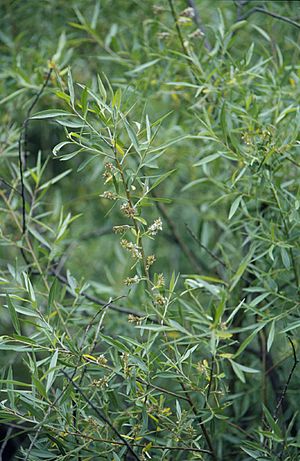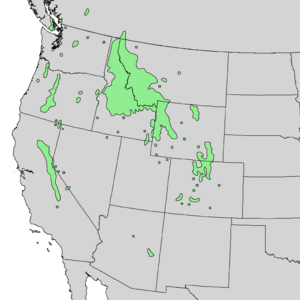Geyer's willow facts for kids
Quick facts for kids Geyer's willow |
|
|---|---|
 |
|
| Scientific classification | |
| Genus: |
Salix
|
| Species: |
geyeriana
|
| Hybrids | |
*Note: only natural hybrids are listed here. |
|
 |
|
| Natural range of Salix geyeriana | |
| Synonyms | |
|
|
Geyer's willow, also known as Salix geyeriana, is a type of willow plant. People also call it Geyer willow or silver willow. It got its name from a botanist named Karl Andreas Geyer, who first collected a sample of it. This plant has bright yellow flowers. These flowers can start blooming as early as March and continue until the end of June.
Contents
What Geyer's Willow Looks Like
Salix geyeriana is a shrub. This means it is a woody plant that is smaller than a tree. It can grow up to 5 meters (about 16 feet) tall. Sometimes, many of these plants grow together. They form thick groups called colonial thickets.
Leaves and Flowers
The leaves of Geyer's willow are long and narrow. They can be shaped like a spear or a wider blade. Some leaves can grow longer than 7 centimeters (about 2.8 inches). Young leaves often have soft, white or light-colored hairs. Some older leaves keep these hairy textures.
Most leaves do not have stipules. Stipules are small leaf-like parts found at the base of a leaf stalk. If they do have them, they are very tiny and not fully developed. The flowers grow in a cluster called a catkin. These catkins are usually round or slightly long. They are typically no more than 2 centimeters (about 0.8 inches) long.
How Geyer's Willow Reproduces
This willow plant can make new plants in two ways. One way is through sexual reproduction using seeds. The other way is vegetative reproduction. This means new plants can grow from parts of the parent plant. For example, new plants can sprout from the stem or pieces of the stem. These stem pieces have early root structures. They can easily grow into new plants if they are buried in wet soil.
Where Geyer's Willow Lives
Salix geyeriana likes to grow in wet places. You can find it near lakes, along riverbanks, and in bogs. Bogs are wetlands with soft, spongy ground.
Where Geyer's Willow is Found
Salix geyeriana is native to western North America. This means it naturally grows in this area. You can find it in southern British Columbia in western Canada. In the United States, it grows in Washington, central Idaho, western Montana, and Wyoming. It is also found in eastern Oregon, Nevada, and northern Utah. Its range extends to southern and western Colorado, central California, eastern and central Arizona, and western New Mexico.
It grows in several mountain regions. These include the Great Basin, the High Cascades, the Rockies, and the northern and southern High Sierra Nevada. It is also found in the San Bernardino Mountains. There are many Geyer's willow plants on the Kern Plateau.
Willow Hybrids
It can be tricky to identify Geyer's willow. This is because it often mixes with other willow types. When different willow species mix, they create hybrids. These hybrid plants can look different from their parent plants.
Common Hybrids
One common natural hybrid is S. geyeriana mixed with S. lemmonii. This hybrid is found in British Columbia, Oregon, and California.
Other hybrids include:
- S. geyeriana mixed with S. bebbiana in Montana.
- S. geyeriana mixed with S. pedicellaris in Washington.
- S. geyeriana mixed with S. irrorata and S. ligulifolia in Arizona.
How Wildlife Uses Geyer's Willow
Geyer's willow is an important food source for many animals. Moose (Alces alces) and elk (Cervus canadensis) eat it all year round. It is especially important for them during winter when other food is scarce.
Many smaller animals also eat parts of the plant. Grouse (a type of bird), ducks, and other small birds eat its buds, catkins, shoots, and leaves. Small mammals also enjoy these parts. North American beavers (Castor canadensis) use Salix geyeriana to build their beaver dams. It is one of many willow species they use for building.
See also
 In Spanish: Salix geyeriana para niños
In Spanish: Salix geyeriana para niños

